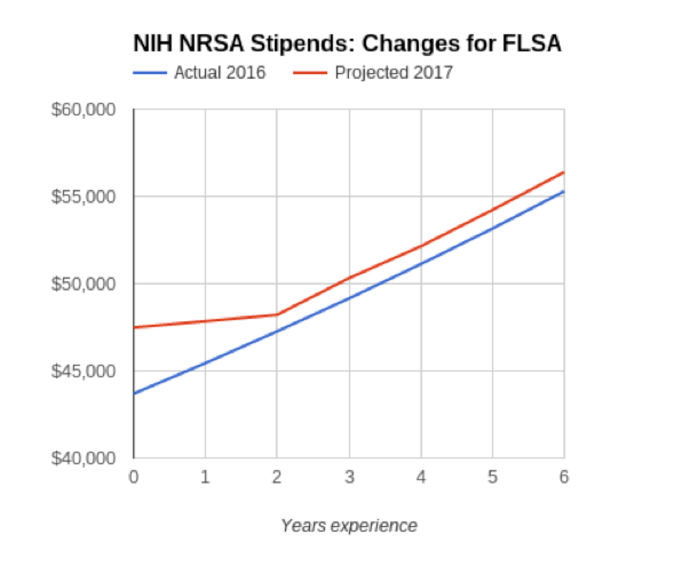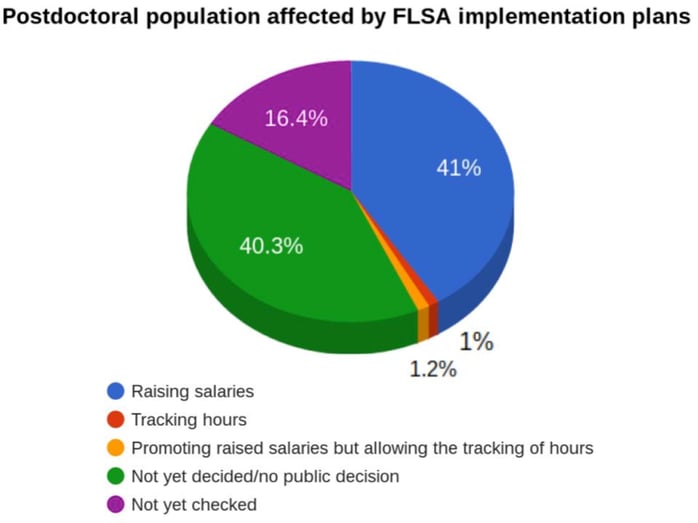This post was contributed by Future of Research Executive Director, Gary McDowell.
On Dec 1st, the threshold at which salaried workers receive overtime payment for working more than 40 hours per week will increase from $23,660 to $47,476 per year, under updates to the Fair Labor Standards Act (FLSA).
This is having a major effect on scientists within academia, most particularly postdocs working in the U.S., whose current salaries are below the new exemption level (the current average postdoc salary is estimated at around $45,000, but as I’ve discussed elsewhere (slides here) there are many postdocs paid at much lower salaries).
Postdocs (who are not in a primarily teaching role) come under this ruling, regardless of visa or fellowship status, in addition to certain staff scientists and those in technical roles. Therefore, institutions are responsible for ensuring that either all affected scientists are paid above this threshold or for tracking the hours that these scientists work and paying them overtime accordingly.
Read Additional Career Posts on the Addgene Blog
How did this change in labor laws come about?
In March 2014, the White House issued a memorandum to the Secretary of Labor to update the FLSA, which had not seen revisions since 2004. In July 2015, the Department of Labor issued a Notice of Proposed Rulemaking, soliciting feedback by Sept 4th. They proposed raising the salary for exemption to $50,440 and also suggested that the salary level should now be automatically adjusted every 3 years. In May 2016, Secretary of Labor Thomas Perez updated the overtime regulations of the FLSA. The exemption salary was set at $47,476 and the date for implementation was set for Dec 1 2016.
In order to be exempted from the need to pay employees overtime, salaries must be above this level, and certain job duty tests must be met. In the Department of Labor’s general guide to the effect on higher education, you can see that those in teaching roles (such as adjuncts) and graduate and undergraduate students are exempted from the law. However postdocs, staff scientists and technicians in primarily bench-science positions are not.
The lack of an exemption for postdocs in the final ruling was, for a lot of us, frankly quite surprising. Consortia of higher education institutions submitted letters to the Department of Labor (for example here and here) pushing for exemptions for postdocs, and lowering of the proposed salary level for exemption. Discussions about the drastic effects on higher ed had been seized upon by opponents of the ruling. However when the ruling was issued, a joint blog post by Director of the NIH Francis Collins and Secretary of Labor Thomas Perez, Fair Pay for Postdocs: Why We Support New Federal Overtime Rules, made clear that institutional arguments were not as convincing as the recommendations for postdocs to be on higher salaries (which have been made by multiple organizations across academia).
Increased postdoc wages, overtime tracking? What are institutions doing?
Institutions are now preparing to comply with the changes to the law on Dec 1st, according to guidance issued by the Department of Labor. At Future of Research, our volunteers have been helping to gather information for our FLSA and postdocs resource on what institutions are actually doing (using the list of 340 institutions with postdocs in science, engineering and health from the NSF’s 2014 Graduate Student Survey data).
Most institutions suggest that postdocs should be paid according to the National Institutes of Health National Research Service Award (NRSA) stipend levels. In theory, therefore, the salary changes expected for postdocs in many cases should be as described in the notice of the new NRSA levels and in the graph below:
 The minimum should therefore rise from $43,692 to $47,484, an increase of 8.7%. However, it is hard to gauge exactly how postdoctoral salaries are changing. Transparent salary information for postdoctoral positions is very hard to find and this is partly due to the administration of postdocs, often at a departmental level rather than being centrally administered, which leads to many complications, including the inability of some institutions to know exactly how many postdocs they have, much less how much they get paid.
The minimum should therefore rise from $43,692 to $47,484, an increase of 8.7%. However, it is hard to gauge exactly how postdoctoral salaries are changing. Transparent salary information for postdoctoral positions is very hard to find and this is partly due to the administration of postdocs, often at a departmental level rather than being centrally administered, which leads to many complications, including the inability of some institutions to know exactly how many postdocs they have, much less how much they get paid.
Institutional salary policies are one indicatator of how salaries may changes due to the FLSA. In 2014, 89% of institutions had a minimum salary policy: of those, 51% of institutions set their postdoctoral salary scales to the NRSA scale (Figure 21, National Postdoctoral Association Institutional Policy Report 2014). However, ~30% set their minima lower. Furthermore, 7% did not enforce these policies. It is unclear how many postdocs are at each of these institutions (populations potentially from 1 to 5761, according to the NSF data) and therefore the numbers of postdocs at different points on this salary range.
We have been able to gather data on changes to salary for some of the institutions that are meeting the salary requirements of the FLSA. In the University of California system, the postdoc union has negotiated a raise from $43,692 to $48,216, an increase of 10.4%. The Icahn School of Medicine at Mount Sinai in New York is raising the minimum from $43,692 to $50,000, an increase of 14.4%. In 2015, Stanford raised salary levels to $50,000, and as of October 1st the salary minimum was raised again to $51,600, itself a raise of 3.2%.
Other institutions that have not yet announced what they are doing, however, may face greater challenges. Current salary information that we have been able to find suggests that salaries may even double. The University of Notre Dame sets no minimum, stating that while they recommend NRSA levels, postdocs must be at least at the FLSA minimum of $23,660. Any postdocs on such a salary would need to have their salary raised 101% if hours are not to be tracked. University of Buffalo and Ohio State both have minima of $30,000, and raising salaries would require those postdocs receive an increase in salary of 58.3%. University of Delaware has a minimum of $36,360, requiring an increase of 30.6%.
We have attempted to check 123 of the 340 institutions listed as having postdocs, representing ~85% of the postdoctoral workforce. Based on our communications with and research on these institutions, we can say with relative certainty that just over 40% of current postdocs will have their salaries raised to the new level: 
We are still waiting for an indication of what (most of) Harvard, Johns Hopkins, (most of) MIT and the University of Colorado are doing, and are checking with Yale that they are raising salaries as their website implies. These 5 organizations, according to the NSF data, account for 18% of the postdoctoral workforce in the sciences. The Dana Farber Cancer Institute (at Harvard) and MIT BCS (Department of Brain and Cognitive Sciences) and the Whitehead Institute (at MIT) all already have salaries at or above $50,000. Boston Children’s Hospital is the only part of the Harvard group that has responded to the FLSA at the time of writing, and is raising salaries.
In addition, both Brown and Brandeis universities have stated that they consider postdocs paid on stipends to be FLSA exempt, and so will not be mandating raises in the salaries of postdocs on stipends that are below the exemption level. Not only is this in direct contradiction to explicit policies set up other institutions (like University of Washington) but as discussed elsewhere, there seems no basis for this decision in FLSA, and at the time of writing responses to requests for the legal justification of this have not been received.
Future actions for junior scientists and for academia
Changes are afoot for the postdoc population, and it is unclear how this will all shake out. In the short term, postdocs and potential postdocs should be on the lookout for what their institutions, or institutions they're thinking about applying to, are doing - for example, your benefits may be changing. Please also feel free to contact us if you have information that you think would help our resource.
In the medium term, it is unclear what effects the new laws will have on the postdoc population. In the current funding climate combined with the lack of a sustainable research enterprise, there is no easy way for academia to absorb the extra cost of increased salaries. I have heard every possible outcome:
- that many postdocs will immediately lose jobs;
- that tenured professors/mid-career scientists/junior faculty will all be most/least likely to have to get rid of postdocs;
- that current postdoctoral appointments may shorten in length;
- that postdoc salaries will have to double at some institutions; and
- that institutions which can more easily provide bridge funding to absorb the cost will encounter no issues.
In the long term, it seems likely the number of postdoc positions in the biomedical enterprise in the U.S. will decrease. At Future of Research, we think this is a good thing. Reliance on a cheap trainee workforce has clearly not been a sustainable approach to biomedical research in the U.S. and postdoctoral training has not been demonstrated to be required for the jobs that the majority of postdocs end up getting outside academia.
There is also a valuable lesson for the enterprise: the time for talk is over and instead we must make real changes to make the system sustainable. For years, there have been recommendations that postdoc salaries be raised to $50,000 - higher than the level they will be raised to on Dec 1st - across a wide consensus of academic stakeholders. There was ample opportunity to accept these recommendations, and make gradual adjustments towards this new level. Indeed some institutions did this. It doubtless took a lot of time and a lot of work - but they were able to do so on their own terms. They must feel very relieved not to be going through the urgent scramble of their peer institutions.
The issues facing academia are not going away, and it is becoming ever clearer that outside scrutiny of science and the academic system is increasing, and becoming ever more critical. In 2016 not only were postdocs not exempted from FLSA; graduate students at private institutions were given the ability to unionize. It’s time to roll up our sleeves and realize that, while these changes are going to hurt, they are necessary to produce a healthy and sustainable research ecosystem and that we cannot ignore these changes if we wish to minimize the hurt.
Many thanks to our guest blogger Gary McDowell!
 Gary S. McDowell is currently the Executive Director of Future of Research. He is interested in advocating for and with junior scientists, to help them navigate the scientific enterprise and promote their voices in driving changes in science. Follow him on Twitter @BiophysicalFrog and Future of Research @FORsymp.
Gary S. McDowell is currently the Executive Director of Future of Research. He is interested in advocating for and with junior scientists, to help them navigate the scientific enterprise and promote their voices in driving changes in science. Follow him on Twitter @BiophysicalFrog and Future of Research @FORsymp.
Additional Resources on the Addgene Blog
- Read about the 2015 and 2016 Future of Research Symposia
- Prepare Yourself for a New Career in Science with Our Career Readiness Posts
- Learn Good Management for Scientists
Resources on Addgene.org
- Learn about Careers at Addgene
Topics: Science Careers, Early Career Researcher






Leave a Comment